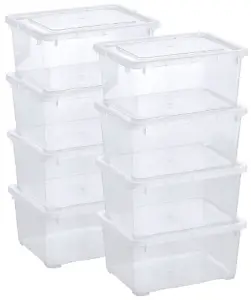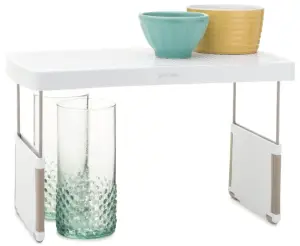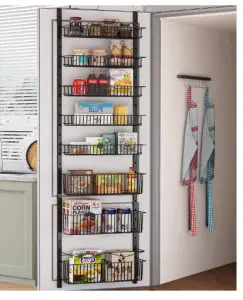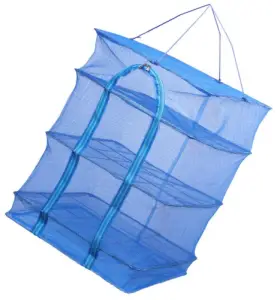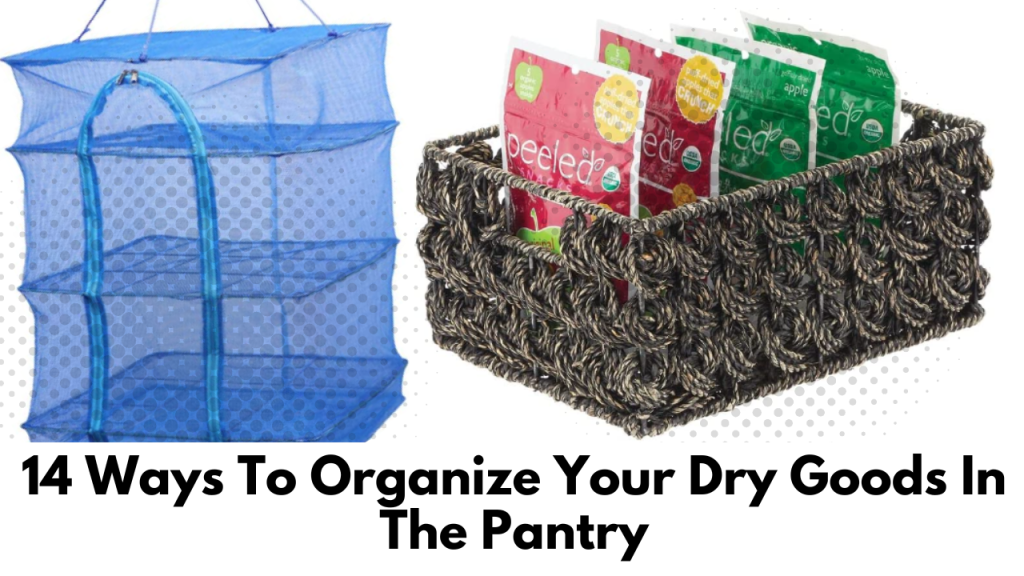
Do you have a pantry filled with dry goods? Do you need help organizing dry foods in the pantry? Organizing dry goods in your pantry can be a hassle, but it doesn’t have to be. You can maintain order in your dry products by using straightforward techniques, which will make meal preparation and ingredient searching a joy.
In this post, we’ll go through 16 various pantry organization ideas and the advantages and disadvantages of each pantry organization system. These ideas will enable you to make the most of your pantry’s space, regardless of size. But first, how do you organize dry goods in the pantry?
When organizing your dry goods in the pantry, start by grouping items together and removing anything over its expiration date. To organize items and keep things neat, use shelves, bins, clear containers with labels, and bins to store them in.
Below is the step-by-step guide to organizing dry foods in the pantry.
1. Use clear containers
Using pantry transparent containers is one of the simplest ways to organize dry goods. It is one of the common pantry organization ideas you will find. This is because you won’t have to search through bags or cartons to discover what you’re searching for, thanks to clear containers that make it simple to see what’s within. They also do an excellent job of keeping pests away from your food.
You won’t have to search through bags or cartons to discover what you’re searching for, thanks to clear containers that make it simple to see what’s within. They also do an excellent job of keeping pests away from your food.
2. Use shelf risers
Use pantry shelf risers to maximize the vertical space in your pantry. Consider adding shelf risers to your current shelves to make more room for dry goods storage. Also, it’s a terrific method to keep your goods accessible and visible.
Using the vertical space in your pantry with shelf risers is a terrific way to make your products accessible and visible. Shelf risers are reasonably priced, simple to install, and available in various sizes. However, unlike opaque containers, shelf risers may take up more room and offer less protection from light for food.
3. Use over-the-door storage
Use the area on the back of your pantry door to store items with an over-the-door storage organizer. The pockets on these organizers are often used to store dry items like snacks and spices.
The back of your pantry door may be used to store over-the-door storage organizers, which often contain pockets for keeping dry products like snacks and spices. Over-the-door storage organizers are reasonably priced, simple to set up, and available in various sizes. However, the capacity and durability of over-the-door storage organizers may be less than those of other solutions.
4. Use drawer organizers
Little goods, like tea bags and hot chocolate sachets, may be kept organized with the help of pantry drawer organizers. As the compartments in these organizers often come in various sizes, you may adjust them to meet your needs.
Items like packets of hot chocolate and tea bags, for example, can be kept neatly in drawer organizers. However, you may alter these organizers to suit your needs because they often feature sections of various sizes. Drawer organizers are affordable, simple to put in, and available in various sizes. However, drawer organizers can not be as durable as other solutions and might need help handling larger things.
5. Use lazy Susans
If your pantry is in a hard-to-reach spot, a pantry lazy Susan is a terrific way to arrange it. For example, you may rotate the shelves with a lazy Susan to reach goods in the rear without moving everything in front of it.
Lazy Susans simplify accessing goods in the back of a corner area without moving the objects in front of it. Lazy Susans are affordable, simple to install, and available in various sizes. However, lazy Susans cannot be as versatile as other alternatives and might need help fitting in small areas.
6. Use label makers
Pantry label makers are a terrific way to keep your pantry organized by marking the contents of your containers and shelves. Doing this lets you locate what you’re searching for and know precisely what’s within.
With the help of label makers, it is simple to identify the contents of a container or shelf and locate the ingredients you’re looking for. The usage of label makers is simple and economical. Label makers are only useful if you have a clear container or the container is transparent.
7. Use baskets
This is another small pantry organization idea you can use to keep your pantry tidy by putting goods in one pantry basket. For example, you may have a basket for breakfast things, one for baking ingredients, and one for snacks. Everything will have a specific place in this manner, making locating what you’re seeking simple.
Similar goods can be conveniently grouped in baskets, making finding what you’re looking for simple. Baskets are accessible and available in various shapes and sizes. However, baskets may not be as durable as other solutions and might take up a lot of room.
8. Use turntables
Pantry turntables may be an excellent organizing tool for storing dry products in the pantry since they make all your contents visible and accessible. In addition, turntables make it simple to spin the objects on a shelf so you can quickly get to what you need without moving other items or reaching toward the rear of the shelf. Turntables also help you make the most of your pantry’s space by letting you store more things in a smaller space.
Turntables may keep your pantry tidy by preventing products from stowing away in the back of the shelf and by allowing you to see what you have quickly. Also, by keeping your dry products accessible and visible, you can ensure they are consumed before they go bad, reducing waste and saving costs.
9. Use door racks
Consider using pantry door racks to store dry products to make the most of available space and increase the pantry’s storage capacity. Door racks can help you optimize your storage capacity by utilizing the empty area inside your pantry door. In addition, door racks allow you to see all of your stuff at a glance, making it easier to keep your dry goods organized and accessible.
Most door racks are easy to install and don’t need any additional equipment or hardware. Door racks may be useful for storing frequently used items due to their accessibility. Unlike alternative pantry storage solutions like built-in shelves or custom cabinets, door racks are usually less expensive. They come in various sizes and forms, so you may choose the one that best matches your taste and pantry.
10. Use wall racks
Dry products should be stored on pantry wall racks in the pantry to make the most of the available space. Using the walls will free up shelf space for other objects, improving organization and simplifying locating the goods you require. Your dry goods are easily visible and accessible thanks to wall racks. They may need help to locate when placed on shelves because they may be pushed back or tucked under other objects. You can quickly view and reach your goods using wall racks, saving time and hassle.
Dry items on wall racks help keep the pantry free of accidents and stains. Items on shelves risk being knocked over or pushed back, creating spills and messes. Wall racks prevent spillage by keeping goods firmly in place. In addition, better airflow is made possible around the dry goods containers by wall racks. This can help avoid moisture from accumulating and keep the containers’ contents fresher for longer.
11. Use hanging racks
By utilizing the vertical space that could otherwise go unused, using pantry hanging racks to store dry products in the pantry helps you make the most of your pantry’s available space. This can simplify arranging your pantry by freeing up important shelf and counter space for other things. Hanging racks also make it simple to reach your dry products. Without rearranging other goods, you can quickly see what you have and take what you need.
In your pantry, hanging racks may assist in clearing up the mess. Items kept on counters or shelves tend to get crowded and unorganized. Using hanging racks, you can keep your pantry organized and quickly find what you need. In addition, dry goods kept on hanging racks can help keep spills and accidents at bay.
12. Use tiered shelves
Use pantry-tiered shelves to store dry goods to make the most of the vertical space in your pantry and fit more products in a smaller space. This can simplify arranging your pantry by freeing up important shelf and counter space for other things. Tiered shelves also make it simple to access your dry products. Without rearranging other goods, you can quickly see what you have and take what you need.
Your pantry’s clutter can be reduced by using tiered shelves. When objects are kept on a single shelf, it is simple for them to get messy and crowded. Tiered shelves make finding what you need simpler and keep your pantry organized. In addition, tiered shelves allow you to personalize them to meet your unique demands because they are available in various sizes and combinations. For example, you may select shelves with various heights and widths to fit containers of various sizes.
13. Use pull-out shelves
Pantry Pull-out shelves for dry goods in the pantry may help you make the most of your available space by enabling you to store more things in a smaller space. This can simplify arranging your pantry by freeing up important shelf and counter space for other things. Your dry products are easy to reach, thanks to pull-out shelves. This can help you save time and prepare meals more effectively. Pull-out shelves for dry goods storage can assist in reducing spills and messes.
Pull-out shelves help your pantry become less cluttered. Items kept on counters or shelves tend to get crowded and unorganized. Pull-out shelves make finding what you need simpler and keep your pantry organized. In addition, pull-out shelves allow you to personalize them to meet your unique demands because they are available in various sizes and combinations.
14. Use stackable bins
You can store more products in a smaller space by using pantry stackable bins to make the most of the vertical space in your pantry. This can simplify arranging your pantry by freeing up important shelf and counter space for other things. In addition, your dry items are simple to access, thanks to stackable containers. Just take the trash out and look inside to see what you have. This can help you save time and prepare meals more effectively.
Items kept on counters, or shelves tend to get crowded and unorganized. Stackable containers make finding what you need simpler and keep your pantry organized.
Conclusion
Make the pantry more space-efficient, less cluttered, and simpler to find what you need by organizing the dry products inside. Wall racks, hanging racks, tiered shelves, pull-out shelves, and stackable bins are a few options for arranging dry goods.
Each approach has its benefits, including making the most of available space, facilitating access, eliminating spillage, minimizing clutter, allowing for customization, and enhancing the look of your pantry.
You may build a practical and attractive pantry that simplifies meal preparation by selecting the best storage option for your needs. Then, make your pantry functional for you and your family with a little structure and hard work.

